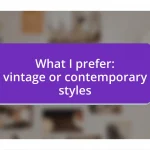Key takeaways:
- Upcycled materials transform waste into functional art, enhancing creativity while promoting sustainability and resourcefulness.
- Practical techniques like repurposing, sewing, and decoupage demonstrate how discarded items can be creatively reimagined into valuable products.
- Future trends indicate a rising integration of upcycling in mainstream fashion, technological advancements in waste analysis, and community initiatives fostering collaboration for sustainability.

Introduction to upcycled materials
Upcycled materials are those that have been repurposed or transformed to give them a new life, often turning what would otherwise be waste into something beautiful and functional. I remember the first time I laid my hands on a stack of old wooden pallets; they seemed so ordinary yet full of potential. Who would have thought those worn-out pieces could become stunning furniture?
As I began working with upcycled materials, I found a deeper connection not only to the objects themselves but also to the environment. Each piece carries a story—from the history of its previous use to the craftsmanship involved in its transformation. Have you ever considered how much energy and resources go into creating something new? It really got me thinking about sustainability and the impact of design choices.
Choosing to incorporate upcycled materials into my designs has been both an exciting and reflective journey. It’s remarkable to see how creativity can breathe new life into discarded items, sparking conversations about conservation and innovation. The thrill of turning something seemingly useless into a work of art truly speaks to the power of imagination.

Benefits of upcycling in design
Upcycling in design not only enhances creativity but also promotes resourcefulness. I recall a project where I transformed discarded glass bottles into elegant vases. The process required some ingenuity, but the thrill of crafting something unique from what most would overlook was just exhilarating. Each vase became a conversation starter, showcasing how upcycling adds character and charm to any space.
One of the most gratifying aspects of upcycling is its positive environmental impact. By choosing to repurpose materials, I’m reducing waste and minimizing the demand for new resources. When I first delivered a collection of upcycled furniture to a local cafe, the owner was overjoyed. Not only did it save money, but it also aligned perfectly with their sustainability goals. It felt rewarding to contribute to something bigger than myself—it’s an experience that leaves a lasting impression.
Cost-effectiveness is another undeniable benefit of upcycling. I remember when I sourced materials for an art exhibit on a budget. By using reclaimed wood and second-hand fabrics, I managed to stay within my financial limits while still producing stunning visuals. This approach also fosters innovation, as it challenges designers to think outside the box and make the most of what’s available. Upcycling has taught me that beauty doesn’t have to come at a high price.
| Benefit | Description |
|---|---|
| Creativity | Enhances resourcefulness by transforming discarded items into unique designs. |
| Environmental Impact | Reduces waste and minimizes demand for new materials. |
| Cost-effectiveness | Offers budget-friendly solutions while encouraging innovation. |

Types of materials for upcycling
When it comes to upcycling, the possibilities regarding materials are limitless. In my experience, some of the most rewarding and versatile materials include fabric scraps, which can transform into beautiful textile art or functional accessories, and old furniture, breathing new life into pieces that may have been destined for the landfill. Each material carries unique characteristics, inspiring various projects that highlight the beauty of imperfection.
Here are some materials that have worked wonders for my upcycling projects:
- Wood: Old furniture, pallets, or even tree branches can be repurposed into stunning home decor or robust outdoor furniture.
- Textiles: Fabric scraps, worn-out clothing, or vintage linens offer endless potential for creating bags, quilts, or soft furnishings.
- Glass: Bottles or jars are perfect for crafting beautiful vases, lanterns, or storage solutions that add a touch of elegance.
- Metals: Discarded tin cans and metal scraps can be shaped into stylish planters or unique wall art that tells a story.
- Paper: Old newspapers, magazines, or cardboard can be transformed into intricate crafts or functional items like notebooks and organizers.
I recall a delightful moment while working on a project with an assortment of old tin cans. I transformed them into charming garden planters, painting them with bright colors and patterns. Seeing those once-discarded pieces filled with vibrant flowers brought me immense joy. It filled me with purpose, reminding me of the potential in what many overlook. Each can had its own history, and now it contributed to the beauty of my garden, shedding light on the idea that creativity can thrive amidst what society deems waste.

Techniques for upcycling materials
When it comes to techniques for upcycling materials, I find that creativity really shines through in the simplest of approaches. For instance, I often use decoupage, a technique where you adhere paper cutouts to a surface, to breathe new life into worn-out furniture. I still remember the satisfaction of taking an old, battered chair and covering it with vibrant magazine cutouts. The transformation was striking, and it made me wonder: what stories could those faded surfaces tell if they could speak?
Another technique I’ve explored is repurposing—finding entirely new functions for items that no longer serve their original purpose. I have this charming old suitcase that was collecting dust in my attic; I turned it into a cozy pet bed. Picture a small pillow nestled inside, complementing the colorful patterns of the suitcase. It not only looked adorable but also saved the suitcase from a fate in the landfill. It made me realize just how much potential lies in things we think are useless.
Sewing is another invaluable technique that can’t be overlooked. It’s incredible how a few stitches can entirely reshape the life of a fabric piece. I once salvaged a pair of torn jeans, transforming them into a trendy tote bag. The process felt like creating something with my own hands, and every time I carry that bag, I think, “How many stories could these worn-out fabrics share?” It’s a small reminder that beauty can emerge from the most unexpected places.

Case studies of successful upcycling
One inspiring case study involves a small boutique in my neighborhood that transformed discarded wooden pallets into stunning furniture pieces. I watched as they meticulously dismantled these pallets, treating each plank with care to create chic coffee tables and rustic bookshelves. It made me think—who would have imagined that something once meant for shipping would find a new life as a statement piece in someone’s living room?
Another remarkable instance is a local artist who specializes in upcycled textiles. She collects swatches of fabric from thrift stores and even her own closet, merging them into striking quilts and wall hangings. I remember visiting her exhibit, where each piece told a story about sustainability and creativity. It prompted me to ponder: how often do we overlook the beauty of our own discarded items? Isn’t it fascinating that our waste can become a canvas for art?
In my personal journey with upcycling, I’ve seen the impact of creating personalized gifts from materials that might otherwise end up in the trash. For example, I crafted flower pots from old teacups and gave them to friends during the holidays. Each one had its own character and history, and watching their joy upon receiving such thoughtful gifts truly resonated with me. It left me wondering: how can we, as individuals, continue to redefine waste into treasures that spark joy in others?

Challenges in upcycling design
Venturing into upcycled design definitely comes with its fair share of challenges. For instance, sourcing suitable materials can sometimes feel like a treasure hunt, requiring patience and creativity. I often find myself rummaging through thrift stores or my own home, wondering, “Will this old lamp base ever find a new purpose?” It’s a mix of excitement and frustration, especially when the perfect piece is elusive.
Another difficulty I face is the unpredictability of material quality. I still vividly recall attempting to convert an old bicycle tire into a belt. It seemed promising, but as I worked with it, I realized the rubber was too stiff and challenging to manipulate. That’s when it hit me: sometimes the vision I have isn’t always compatible with the materials at hand. How do you adapt your creativity when faced with such limitations? It’s a learning curve that constantly shapes my approach.
Lastly, there’s the challenge of consumer perception. A few times, I’ve showcased my upcycled creations at local markets, but I noticed some people hesitating, perhaps alienated by the idea of using “waste.” Does it suggest lower quality, even when the craftsmanship is stellar? This has sparked many conversations for me, making me ask how we can shift the narrative around upcycled goods, highlighting their uniqueness and worth instead of simply viewing them through the lens of their past.

Future trends in upcycled materials
As I look ahead, one notable trend in upcycled materials is their increasing integration into mainstream fashion. I recently saw a high-end designer showcase a collection made entirely from post-consumer waste, and it was both stunning and thought-provoking. This shift raises an interesting question: will consumers start to prioritize sustainability over novelty as part of their identity? I can’t help but wonder how we’ll redefine luxury in a world where upcycled pieces become the norm.
Another emerging trend I’ve noticed is the use of technology in the upcycling process. A friend just introduced me to software that can analyze waste streams, helping manufacturers identify potential upcycled materials. How incredible is it that we now have the ability to optimize our resources right from the design phase? It makes me optimistic about the future. Adopting this blend of creativity and technology seems crucial for maximizing the potential of our discarded items.
Additionally, community-driven initiatives are gaining momentum. I’ve participated in local workshops where people gather to learn upcycling techniques. There’s something incredibly empowering about sharing skills and ideas with others. It leaves me asking: how can these collective efforts lead to a substantial cultural shift in our approach to waste? The camaraderie and inspiration shared during these events only reinforce my belief that together, we can redefine what it means to be sustainable.














